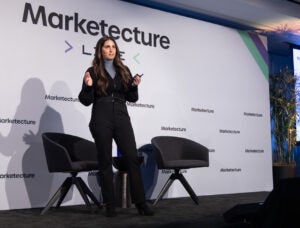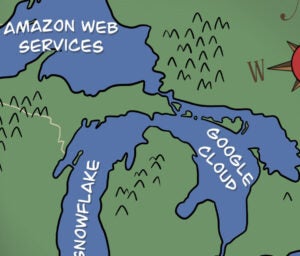Away from the dancing robots, Power Rangers-themed VR experiences, self-driving race cars and the buzzing of drones, deals do get done at Mobile World Congress.
That’s why French location-based dating app Happn came to Barcelona for the show.
“We’re here to have discussions, to gather insights, to see what our competitors are doing, to find potential partners,” said Quentin-Thomas Navaron, a growth and acquisition specialist at Happn.
Berlin-based mobile marketing platform AppLift is angling to become one of Happn’s user acquisition and retargeting partners, and it pitched Happn in a little meeting space tucked away above its booth.
User acquisition topped the agenda. Happn, with more than 20 million users in more than 40 major cities around the world, wants to expand beyond Facebook and Google, its main UA drivers today.
“Could AppLift provide city-based targeting?” asked Happn CMO Benjamin Lorthiois.
A competitor to Tinder, Happn users can see the profiles of other people who frequent the same places they do at the same times.
“We focus on the main cities in every country, so we need a network that offers us the possibility to target cities like London and Paris and others,” said Lorthiois, addressing AppLift senior business development manager Clemente Sacchetti across a small table. “And we can pay on CPI or a CPR [cost per registration]. We need registered users, not only installs.”
Although AppLift can do city targeting on a programmatic basis, the scale just isn’t there, Sacchetti explained. But that’s not so much an AppLift specific problem as an industrywide issue.
If an app developer’s KPI is an event that’s downstream from the actual install – a registration, in Happn’s case – then the targeting parameters (users located in a specific city who are likely to install and register) limit the scale to the point that the pricing doesn’t back out.
Success is also highly dependent on the size of the segments being used, Sacchetti told Lorthiois.
Even a huge brand like Uber would only generate a handful of installs if it tried to run a hyper-targeted campaign hitting fewer than 100,000 or 200,000 people.
“It would be a high price and you wouldn’t necessarily find the users you’re looking for,” Sacchetti said. “It’s like a drop in the sea, depending on the country.”
It’s good to be upfront about that sort of thing with potential clients, Sacchetti told AdExchanger after the meeting.
“One of the peculiarities of this industry as a sales guy is that it’s not actually very difficult to close a deal because there isn’t usually a commitment,” he said. “Test budget doesn’t mean anything. I could sign a $1 million IO, eff it up in two days and have no follow-up budget, and that just leads to waste. It’s more important to manage expectations and try to build a relationship and a setup that works.”
Happn was also particularly concerned with security and asked a number of specific questions about data usage and transparency, including whether it would have to send AppLift a list of user IDFAs, and if it did so, whether that list would ever be used to enrich another client’s campaign.
Because AppLift is based in Berlin, the company is subject to super-strict privacy laws, Sacchetti said. The data would never be shared. An NDA would also preclude any shenanigans.
After about 20 minutes of discussion that closed with a rapid-fire back-and-forth about pricing, the Happn guys were on their way. The deal wasn’t done, but it was a step farther along.
They parted with a handshake and the promise that an AppLift sales guy would travel to Paris to keep nurturing the potential partnership. And then Lorthiois and Navaron melted back into the dense crowd bustling around the showroom floor to seek out their next meeting.














